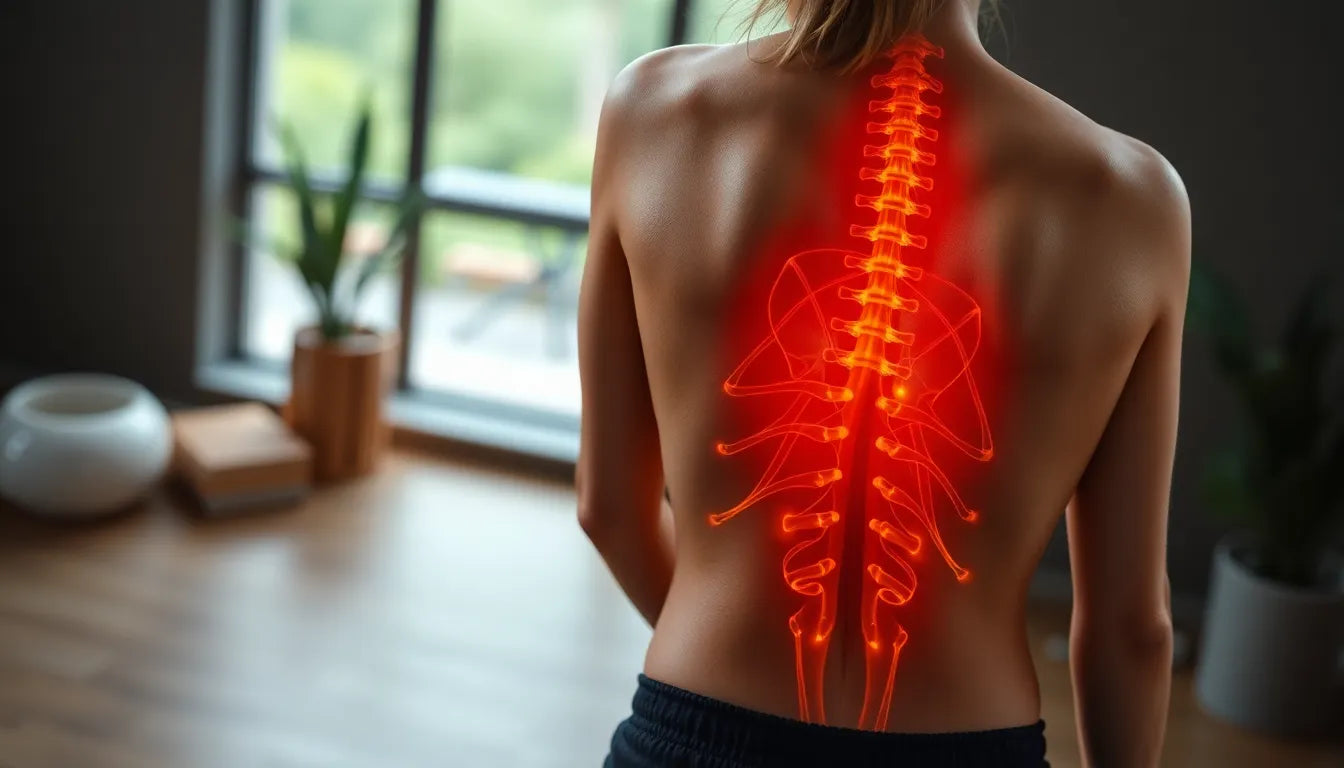Back pain is a common ailment that affects millions worldwide, often dismissed as a minor inconvenience. However, lurking beneath this discomfort can be more serious conditions, such as a herniated disc. This condition can significantly disrupt daily life, presenting symptoms that range from mild to debilitating. Understanding these symptoms is crucial for early intervention and prevention of further complications.
Understanding herniated discs
A herniated disc, also known as a slipped or ruptured disc, occurs when the soft, gel-like center of a spinal disc protrudes through a tear in its tougher exterior. This can happen anywhere along the spine but is most common in the lower back (lumbar spine) and neck (cervical spine). The displacement can irritate nearby nerves, leading to pain, numbness, or weakness in an arm or leg.
Recognizing the symptoms of a herniated disc early is vital. While some individuals may experience severe symptoms, others might have a herniated disc without even knowing it, as it can sometimes be asymptomatic. For those who do experience symptoms, they can vary widely depending on the location of the herniated disc and the nerves affected.
The importance of early detection
Early detection of a herniated disc can prevent the condition from worsening and reduce the risk of long-term complications. Symptoms can manifest differently depending on where the herniation occurs. For instance, a herniated disc in the lumbar spine may cause pain in the lower back and legs, while one in the cervical spine might lead to discomfort in the neck, shoulders, and arms. Recognizing these regional differences is essential for accurate diagnosis and effective treatment.
This post aims to explore the various symptoms associated with a herniated disc, providing insight into their regional differences and when it is necessary to seek medical advice. By understanding the signs and symptoms, individuals can take proactive steps towards managing their condition and maintaining a better quality of life.
Core symptoms of a herniated disc
Understanding the core symptoms of a herniated disc is essential for early detection and effective management. The primary symptom is pain, which can manifest in various forms depending on the location of the herniation. For instance, if the herniated disc is in the lumbar spine, individuals may experience sharp, burning, or electric shock-like pain in the lower back, buttocks, thighs, and calves. Conversely, a herniated disc in the cervical spine typically results in pain that radiates to the shoulder and arm.

Lumbar support belt
Støtter og stabiliserer lænden – ideel ved bl.a. diskusprolaps og lændesmerter.
In addition to localized pain, a herniated disc can cause pain to radiate along the affected nerve pathways. This is often seen in conditions like sciatica, where pain extends from the lower back down to the legs. Similarly, a herniated disc in the cervical region can lead to arm and shoulder pain, as the nerves in these areas are affected.
Numbness, tingling, and muscle weakness
A herniated disc often leads to numbness or tingling sensations in the areas served by the affected nerves. This can occur in the legs, feet, arms, or hands, depending on the disc's location. These sensations are caused by the nerve being compressed or irritated by the protruding disc material.
Muscle weakness is another critical symptom. It can manifest as difficulty lifting objects, problems with grip strength, or stumbling due to weakened leg muscles. In severe cases, this weakness can impair coordination, making everyday tasks challenging.
Serious symptoms requiring immediate attention
While many symptoms of a herniated disc can be managed with conservative treatment, some require immediate medical attention. Bowel or bladder dysfunction is a rare but serious symptom indicating possible nerve root compression. This condition, known as cauda equina syndrome, demands urgent medical intervention to prevent permanent damage.
Additionally, herniated discs in the thoracic spine, though less common, can present unique symptoms. These may include mid-back pain that wraps around the chest, difficulty walking, or progressive limb weakness. Such symptoms should not be ignored, as they may indicate significant nerve involvement.
Asymptomatic cases and diagnostic approaches
Interestingly, not all herniated discs cause symptoms. Some individuals may have herniated discs discovered incidentally during imaging for unrelated issues. This highlights the importance of diagnostic imaging, such as MRI, in confirming a herniated disc diagnosis, especially when symptoms are present.
During a physical examination, healthcare providers often test for muscle strength, sensation, and reflexes to assess the extent of nerve involvement. These assessments, combined with imaging results, help in formulating an accurate diagnosis and developing an effective treatment plan.
In conclusion, recognizing the symptoms of a herniated disc is crucial for timely intervention and prevention of further complications. By understanding the nature of the pain, the associated numbness or tingling, and the potential for serious symptoms, individuals can seek appropriate medical advice and improve their quality of life.
Regional differences in herniated disc symptoms
Understanding the regional differences in herniated disc symptoms is crucial for accurate diagnosis and treatment. The location of the herniated disc significantly influences the type and severity of symptoms experienced. For instance, a herniated disc in the lumbar spine often results in pain radiating from the lower back to the legs, commonly referred to as sciatica. This can cause discomfort in the buttocks, thighs, and calves, making activities like walking or standing for long periods challenging.
In contrast, a herniated disc in the cervical spine typically affects the neck and upper body. Individuals may experience pain that radiates to the shoulders and arms, often accompanied by numbness or tingling in the fingers. These symptoms can hinder everyday activities, such as lifting objects or typing, due to weakened grip strength.

Men's Posture Shirt™ - Black
Aktiverer musklerne og kan afhjælpe smerter i nakke, skuldre og ryg.
Although less common, herniated discs in the thoracic spine can present unique challenges. Symptoms may include mid-back pain that wraps around the chest and can mimic heart or lung issues. Progressive limb weakness and difficulty walking are also potential indicators, emphasizing the need for prompt medical evaluation.
Recognizing red flag symptoms
While many herniated disc symptoms can be managed with conservative treatments, certain red flag symptoms require immediate medical attention. Bowel or bladder dysfunction, for example, is a serious sign that may indicate cauda equina syndrome, a condition where nerve roots at the spine's base are compressed. This requires urgent intervention to prevent permanent damage.
Progressive weakness in the limbs is another critical symptom that should not be ignored. It suggests significant nerve involvement and necessitates a thorough medical evaluation to determine the appropriate course of action.
Conclusion
In summary, recognizing the symptoms of a herniated disc and understanding their regional differences is essential for early intervention and effective management. Whether the symptoms manifest in the lower back, neck, or mid-back, timely medical consultation can prevent further complications and improve quality of life.
If you experience persistent or severe symptoms, it is crucial to seek medical advice. Healthcare professionals can provide a comprehensive evaluation, employing diagnostic tools like MRI to confirm the diagnosis and guide treatment decisions.
Frequently Asked Questions
What are the most common symptoms of a herniated disc?
The most common symptoms include pain, numbness, tingling, and weakness in the affected area. The specific symptoms depend on the location of the herniated disc.
How do symptoms differ between lumbar and cervical herniated discs?
In the lumbar region, symptoms typically include pain in the lower back and legs. Cervical herniated discs usually cause pain in the neck, shoulders, and arms.
Can a herniated disc heal on its own?
Many cases improve with rest and conservative treatment, such as physical therapy and medication. However, severe cases may require medical intervention.
When should I seek medical attention for a herniated disc?
Seek medical attention if you experience severe symptoms, such as bowel or bladder dysfunction, significant weakness, or persistent pain that does not improve with rest.
What diagnostic tests are used for a herniated disc?
Diagnostic tests include a physical examination to assess muscle strength, sensation, and reflexes, as well as imaging tests like MRI to confirm the diagnosis and identify affected nerves.
Källor
- Mayo Clinic Staff. "Herniated Disk: Symptoms & Causes." Mayo Clinic.
- "Herniated Disc Symptoms." NewYork-Presbyterian.
- Gentile, Dr. "What Does a Herniated Disc Feel Like?" Gentile Spine.
- "Herniated Disc." American Association of Neurological Surgeons.
- "Herniated Disc." Hospital for Special Surgery.
- "Understanding Herniated Disc Symptoms." YouTube.
- "Herniated Lumbar Disc." NCBI Bookshelf.
- "Herniated Disk." Cleveland Clinic.


















